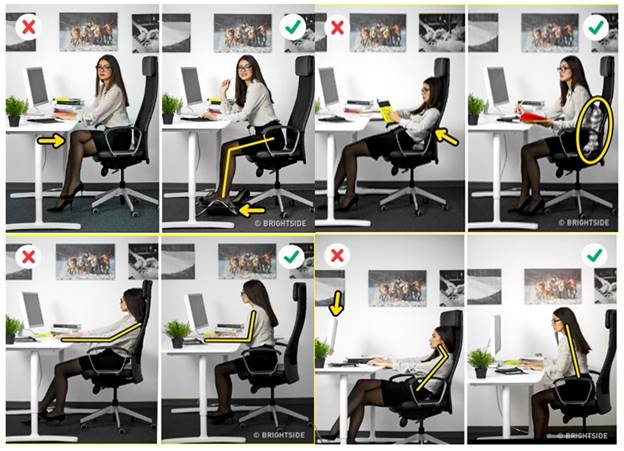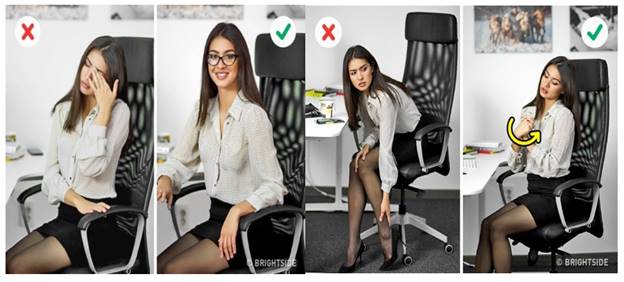Advertisements
How we sit reflects a lot on our natural posture. Most muscle pain and fatigue are caused by 75% sitting in a wrong posture and 25% by overworking and not giving the body enough time to rest.
We will be briefly discussing some of the highly recommended (by practitioners) sitting positions and practices at places of work that do not lead to any health-related problems.

If you’re having leg pain problems refrain from cross either your legs or your feet. Crossing your legs/feet reduces or restricts blood circulation by squeezes your veins and leads to discomfort in the form of restless legs syndrome and numbness. The best way to remedy leg pain is firstly adjusting your chair by making sure your legs are not in a hanging position and are firmly rested on the ground or a firm platform. Also make sure the edge of the seat is not pressing under your knees. Try to bend your feet at an angle of 90 to 100 degrees as they rest on the ground.
Back pain is mainly caused by sitting at a slouching position for long periods of time. You can reduce back pain by making sure that the length of you hips matches the depth of the chair. If the chair is too big, add a pillow at the lower back and waist to reduce the load partly. You should always choose chairs with a back that is comfortable with a natural carve. Make sure to maintain the correct sitting posture. Even if at fast you will fill some discomfort, your muscles and body will eventually get used to the it.
Tired hands are mainly caused tension build up after typing or writing continuously for an extended. Sitting in an awkward or wrong position increases the load on the hands and may cause slight but nagging pain together with a feeling of numbness in the hands. To elevate this, make sure your elbows are at the same level as the mouse and keyboard. For the position of your forearms to be correct your arms should bend at the elbow at 90 degrees and should be resting on the table.
Neck pain when working on your desk or workspace is mainly caused by wrong positioning of the monitor. This can be remedied by simply positioning the monitor to suit your sitting posture. Make sur it is not too low since it will force you to awkwardly lean forward, bend your and even slide down the chair. This results to an increased load on the intervertebral discs and may even go on to issues like hernia or protrusion. The screen should always be directly in front of your eyes when you are sited up straight.

Sore and tired eyes are as a result of sitting in front of your monitor for too long. This may result is some so-called computer vision syndrome which cause dryness, blurred vision, and redness. This may also lead to headache and irritation. To avoid this, make sure your monitor is well positioned as highlighted earlier and should be at least 50cm from your eyes. Try to avoid any screen glare by placing your monitor away from sunlight. Also make use of picture adjustments in terms of font size, contract and brightness. There are also special kinds of spectacles made for people who work with computers for long hours.
As a bonus, make sure you find time to exercise every day or on a regular basis if your schedule is too tight. Even simple gymnastics and stretches for 15 minutes every day is enough is done well and consistently. Watch what you eat and avoid foods rich in carbs and fats as they leave you feeling tired after working for even a short time. Walking or cycling to work is also a great idea.
Advertisements
Advertisements
